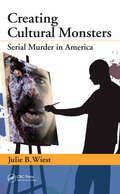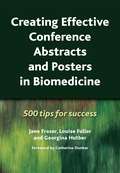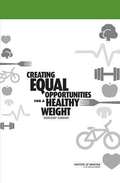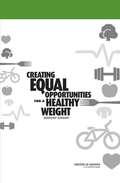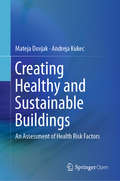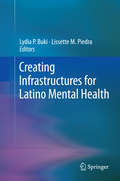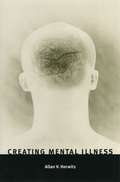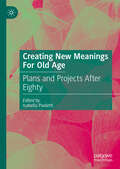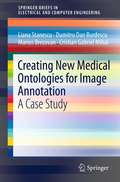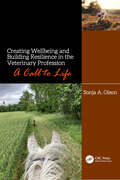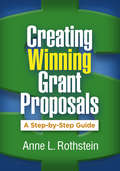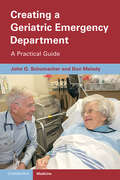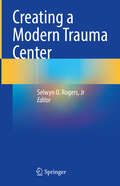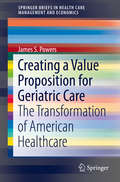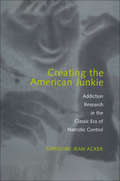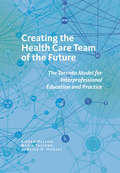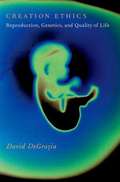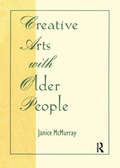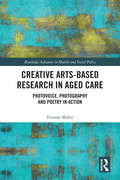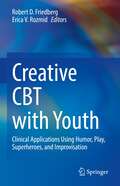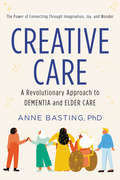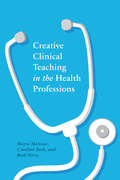- Table View
- List View
Creating Cultural Monsters: Serial Murder in America
by Julie B. WiestProviding a comprehensive exploration, this volume explains connections between American culture and the incidence of serial murder, including reasons why most identified serial murderers are white, male Americans. Presenting empirically supported arguments that have the potential to revolutionize how serial murder is understood, this volume includes an illustrated model that explains how people utilize cultural values to construct lines of action according to their cultural competencies. It demonstrates how the American cultural milieu fosters serial murder and the creation of white male serial murderers and provides a critique of the American mass media‘s role in the notoriety of serial murder.
Creating Culturally Appropriate Outside Spaces and Experiences for People with Dementia: Using Nature and the Outdoors in Person-Centred Care
by Judith Jones Inoue Jane Gilliard Mary Marshall James Mckillop Sidsel Bjorneby Beth Britton Gillian Maclean Kate Andrews Sarah Waller Margaret-Anne Tibbs Joan Domicelj Wendy Hulko Abigail Masterton HirokoDemonstrating that it is essential to be sensitive to the cultural backgrounds of people with dementia in order to provide truly person-centred care, this book shows that it is possible to create culturally appropriate outdoor spaces and experiences that resonate with people with dementia on a fundamental level and are a source of comfort and wellbeing. Contributors drawn from a variety of backgrounds describe the significance of nature in the lives of people with dementia from diverse cultures, faiths, traditions and geographical locations, providing helpful insights into how access to the natural world may be achieved within different care settings. There are contributions from the UK (Scottish island, urban North East England and Norfolk farming communities), Canada, Norway, Japan, Australia, Sudan and South Africa, as well as a chapter on the specific difficulty of providing access to nature for people with dementia in hospitals. The voices of people with dementia and their carers are prominent throughout, and the book also contains evocative poetry and photographs of people with dementia enjoying nature and the outdoors in different contexts. A rich source of information and ideas for all those interested in creating culturally appropriate outdoor spaces and experiences for people with dementia, including dementia care practitioners, especially those at managerial level, policy makers, commissioners and those involved in designing and commissioning buildings and services.
Creating Effective Conference Abstracts and Posters in Biomedicine: 500 Tips for Success
by Jane Fraser Louise Fuller Georgina HutberFor most biomedical researchers and academics, preparing conference abstracts and posters is an important part of professional life. With good preparation and practice, all scientists can produce abstracts that act as effective ambassadors for their research. A well designed poster can help you to enhance your professional reputation in addition to communicating your data. This book aims to help you achieve these objectives. This book is designed for you to use when you are actually preparing a conference abstract or poster. It is intended to answer the most frequent questions, and to help you avoid the most common problems and pitfalls. Just dip into any chapter and you will find a range of tips relevant to the abstract or poster you are preparing right now. As a researcher and academic, you need to be able to disseminate and communicate your research work and findings. While many will view writing for peer-reviewed journals as the pinnacle of the academic communication hierarchy, being able to write and present conference abstracts and posters is also extremely important. Taking your work to conferences allows you to meet experts from all around the world, to exchange ideas in person and to network with potential employers and collaborators. 'This book is a gem of useful, practical tips covering the entire process - from reading the abstract submission guidelines, through to writing and laying out your poster and creating e-posters. If you are a novice this is the ideal book to guide you through every step. And, even if you consider yourself an expert, there is bound to be some useful information you can glean from the 500 or so tips. By reading this book, in sequence, or by dipping into relevant chapters, you will have all the necessary help with preparing abstracts and posters right at your fingertips' - Catherine Dunbar in her Foreword.
Creating Equal Opportunities for a Healthy Weight
by Institute of Medicine Steve Olson Lynn Parker Standing Committee on Childhood Obesity Prevention Food and Nutrition Board Heather BreinerCreating Equal Opportunities for a Healthy Weight is the summary of a workshop convened by the Institute of Medicine's Standing Committee on Childhood Obesity Prevention in June 2013 to examine income, race, and ethnicity, and how these factors intersect with childhood obesity and its prevention. Registered participants, along with viewers of a simultaneous webcast of the workshop, heard a series of presentations by researchers, policy makers, advocates, and other stakeholders focused on health disparities associated with income, race, ethnicity, and other characteristics and on how these factors intersect with obesity and its prevention. The workshop featured invited presentations and discussions concerning physical activity, healthy food access, food marketing and messaging, and the roles of employers, health care professionals, and schools. The IOM 2012 report Accelerating Progress in Obesity Prevention acknowledged that a variety of characteristics linked historically to social exclusion or discrimination, including race, ethnicity, religion, socioeconomic status, gender, age, mental health, disability, sexual orientation or gender identity, geographic location, and immigrant status, can thereby affect opportunities for physical activity, healthy eating, health care, work, and education. In many parts of the United States, certain racial and ethnic groups and low-income individuals and families live, learn, work, and play in places that lack health-promoting resources such as parks, recreational facilities, high-quality grocery stores, and walkable streets. These same neighborhoods may have characteristics such as heavy traffic or other unsafe conditions that discourage people from walking or being physically active outdoors. The combination of unhealthy social and environmental risk factors, including limited access to healthy foods and opportunities for physical activity, can contribute to increased levels of chronic stress among community members, which have been linked to increased levels of sedentary activity and increased calorie consumption. Creating Equal Opportunities for a Healthy Weight focuses on the key obesity prevention goals and recommendations outlined in Accelerating Progress in Obesity Prevention through the lens of health equity. This report explores critical aspects of obesity prevention, while discussing potential future research, policy, and action that could lead to equity in opportunities to achieve a healthy weight.
Creating Equal Opportunities for a Healthy Weight
by Heather Breiner"Creating Equal Opportunities for a Healthy Weight" is the summary of a workshop convened by the Institute of Medicine's Standing Committee on Childhood Obesity Prevention in June 2013 to examine income, race, and ethnicity, and how these factors intersect with childhood obesity and its prevention. Registered participants, along with viewers of a simultaneous webcast of the workshop, heard a series of presentations by researchers, policy makers, advocates, and other stakeholders focused on health disparities associated with income, race, ethnicity, and other characteristics and on how these factors intersect with obesity and its prevention. The workshop featured invited presentations and discussions concerning physical activity, healthy food access, food marketing and messaging, and the roles of employers, health care professionals, and schools. The IOM 2012 report "Accelerating Progress in Obesity Prevention" acknowledged that a variety of characteristics linked historically to social exclusion or discrimination, including race, ethnicity, religion, socioeconomic status, gender, age, mental health, disability, sexual orientation or gender identity, geographic location, and immigrant status, can thereby affect opportunities for physical activity, healthy eating, health care, work, and education. In many parts of the United States, certain racial and ethnic groups and low-income individuals and families live, learn, work, and play in places that lack health-promoting resources such as parks, recreational facilities, high-quality grocery stores, and walkable streets. These same neighborhoods may have characteristics such as heavy traffic or other unsafe conditions that discourage people from walking or being physically active outdoors. The combination of unhealthy social and environmental risk factors, including limited access to healthy foods and opportunities for physical activity, can contribute to increased levels of chronic stress among community members, which have been linked to increased levels of sedentary activity and increased calorie consumption. "Creating Equal Opportunities for a Healthy Weight" focuses on the key obesity prevention goals and recommendations outlined in "Accelerating Progress in Obesity Prevention" through the lens of health equity. This report explores critical aspects of obesity prevention, while discussing potential future research, policy, and action that could lead to equity in opportunities to achieve a healthy weight.
Creating Healthy and Sustainable Buildings: An Assessment of Health Risk Factors
by Mateja Dovjak Andreja KukecThe open access book discusses human health and wellbeing within the context of built environments. It provides a comprehensive overview of relevant sources of literature and user complaints that clearly demonstrate the consequences of lack of attention to health in current building design and planning. Current designing of energy-efficient buildings is mainly focused on looking at energy problems and not on addressing health. Therefore, even green buildings that place environmental aspects above health issues can be uncomfortable and unhealthy, and can lead to public health problems. The authors identify many health risk factors and their parameters, and the interactions among risk factors and building design elements. They point to the need for public health specialists, engineers and planners to come together and review built environments for human wellbeing and environmental sustainability. The authors therefore present a tool for holistic decision-making processes, leading to short- and long-term benefits for people and their environment.
Creating Infrastructures for Latino Mental Health
by Lydia P. Buki Lissette M PiedraLatinos are the fastest growing and largest minority group in the United States. In 2008, this group numbered over 47 million; by 2050, the population is expected to triple, reaching 133 million. Traditionally, Latinos have immigrated to large urban centers (e.g., New York, Los Angeles) that over long periods of time developed a complex infrastructure to receive new immigrants. Increasingly, new Spanish-speaking immigrants are moving into areas of the country previously unfamiliar to them. Although urban co-ethnic communities continue to be the destination of many newcomers, immigrants from Mexico, Central America, and South America in pursuit of low-skilled labor opportunities are settling in small towns and rural areas of the South and Midwest. This new demographic trend has resulted in the creation of the term "new growth communities," which refers to small rural areas that are now home to a small but rapidly growing Hispanic population. Unfortunately, these communities, which are now present in many states across the country (e.g., Illinois, North Carolina), lack the infrastructure necessary to meet the needs of Latino immigrants (e.g., access to health care, immigration assistance, and breaking down language barriers). The lack of an infrastructure and the lack of an established ethnic community to facilitate the assimilation of new immigrants present an ongoing challenge, especially in the area of Latino mental health. The volume focuses on dealing with systemic issues and on providing innovative ideas for development of infrastructure of services. This text will advance ways to understand and ameliorate mental health disparities both from research and experiential perspectives.
Creating Mental Illness
by Allan V. HorwitzIn this surprising book, Allan V. Horwitz argues that our current conceptions of mental illness as a disease fit only a small number of serious psychological conditions and that most conditions currently regarded as mental illness are cultural constructions, normal reactions to stressful social circumstances, or simply forms of deviant behavior.
Creating Mental Illness
by Allan V. Horwitz&“Filled with insights into the social, historical, and economic forces responsible for the overmedicalization of human unhappiness and distress.&” —George Graham, Metapsychology In this surprising book, Allan V. Horwitz argues that our current conceptions of mental illness as a disease fit only a small number of serious psychological conditions and that most conditions currently regarded as mental illness are cultural constructions, normal reactions to stressful social circumstances, or simply forms of deviant behavior.&“Thought-provoking and important . . . Drawing on and consolidating the ideas of a range of authors, Horwitz challenges the existing use of the term mental illness and the psychiatric ideas and practices on which this usage is based . . . Horwitz enters this controversial territory with confidence, conviction, and clarity.&” —Joan Busfield, American Journal of Sociology&“Horwitz properly identifies the financial incentives that urge therapists and drug companies to proliferate psychiatric diagnostic categories. He correctly identifies the stranglehold that psychiatric diagnosis has on research funding in mental health. Above all, he provides a sorely needed counterpoint to the most strident advocates of disease-model psychiatry.&” —Mark Sullivan, Journal of the American Medical Association&“Horwitz makes at least two major contributions to our understanding of mental disorders. First, he eloquently draws on evidence from the biological and social sciences to create a balanced, integrative approach to the study of mental disorders. Second, in accomplishing the first contribution, he provides a fascinating history of the study and treatment of mental disorders . . . from early asylum work to the rise of modern biological psychiatry.&”— Debra Umberson, Quarterly Review of Biology
Creating New Meanings For Old Age: Plans and Projects After Eighty
by Isabella PaolettiThis edited volume proposes a radical change in perspective, fighting the prevalent ageist culture that tends to relegate the oldest old to isolation and irrelevance. The chapters show that having plans and projects, being involved in life, is possible for those aged 80 and over, as well as for oldest old people with disabilities. Exploring the involvement of oldest old people in various activities that make them feel happy, worthy, and connected, this volume builds on a large empirical literature documenting that a sense of purpose in life is associated with delayed mortality and reduced health risks. In doing so, this book aims to combat widespread ageist attitudes at an interactional and institutional level, and shift the focus from loss and decay to adaptability, involvement, inner strength, and resilience. It illuminates how oldest old people are inventing new meanings for ageing.
Creating New Medical Ontologies for Image Annotation: A Case Study (SpringerBriefs in Electrical and Computer Engineering)
by Liana Stanescu Dumitru Dan Burdescu Marius Brezovan Cristian Gabriel MihaiCreating New Medical Ontologies for Image Annotation focuses on the problem of the medical images automatic annotation process, which is solved in an original manner by the authors. All the steps of this process are described in detail with algorithms, experiments and results. The original algorithms proposed by authors are compared with other efficient similar algorithms. In addition, the authors treat the problem of creating ontologies in an automatic way, starting from Medical Subject Headings (MESH). They have presented some efficient and relevant annotation models and also the basics of the annotation model used by the proposed system: Cross Media Relevance Models. Based on a text query the system will retrieve the images that contain objects described by the keywords.
Creating Wellbeing and Building Resilience in the Veterinary Profession: A Call to Life
by Sonja A. OlsonA Call to Life aims to help veterinary caregivers increase self-efficacy, decrease unnecessary suffering, and increase sustainability in their mission to support animal health around the world. The veterinary profession is powered by dedicated, bright, and selfless individuals. Unfortunately, the long-standing and dysfunctional culture in classrooms and practices around the world expects veterinary caregivers to be ready to sacrifice everything – their time, their health, their personal lives – in the name of being deemed qualified and ‘worthy.’ Integrating real-life stories from a range of veterinary caregivers with evidence-based theory, practical activities, discussion and reflection points, and insights drawn from the author’s own experiences, the book empowers veterinarians by showing that they have the ability and the control to choose a healthier way forward for themselves and for their profession. It describes how to: Normalize the conversation around mental and emotional health challenges in caregiving environments Discuss and collaboratively create systemic solutions that promote healthier ‘ecosystems’ for vets to work within Develop the skills of reframing, mindfulness, and self-care strategy implementation supporting holistic veterinary well-being Collectively choose to shift the framework of professional conversations towards psychological safety, optimism, and purpose-driven experiences. Creating Wellbeing and Building Resilience in the Veterinary Profession: A Call to Life uniquely combines shared experiences (personal stories) with academic research into the contributing factors of compassion fatigue and how to counter these. Normalizing the conversation in the profession, it provides a wide array of possible solutions to build resilience and to shape a culture of collaboration and support where caregivers can flourish.
Creating Winning Grant Proposals: A Step-by-Step Guide
by Anne L. RothsteinProviding clear-cut steps for producing each section of a competitive grant proposal, this hands-on book is filled with examples from actual RFPs and proposals, practical tools, and writing tips. Prominent educator and successful proposal writer Anne L. Rothstein shares a systematic process created over decades of experience in the field. She details how to: achieve group consensus around a project; identify likely funding sources; establish need; develop objectives; assemble a Master Project Table and other needed tables, figures, and charts; create an effective logic model; prepare an evaluation; put together a budget; tailor the proposal to meet the requirements of funders; and avoid common errors. Purchasers get access to a Web page where they can download and print the book's 14 reproducible templates in a convenient 8 1/2" x 11" size.
Creating a Geriatric Emergency Department: A Practical Guide
by John Schumacher Don MeladyGlobally, EDs face new challenges as the world's population ages. Visits from older people are predicted to rise for the next 20 years. This practical and accessible book provides essential guidance on assessing the ED care of older patients - and improving it. It assists ED teams to implement changes tailored to their unique environments, providing guidance across all settings regardless of size, location or resources. Experience- and evidence-based elements combine to guide best practices for older patient flow, staff and patient satisfaction, and improving patient health outcomes. The book features proven ideas for creating a geriatric ED such as specific staff training, modifying job roles, implementing new care processes, and adapting physical spaces. An invaluable resource for practising ED clinicians, leaders, administrators, educators, and system change leaders.
Creating a Lifestyle Medicine Center: From Concept to Clinical Practice
by Robert F. Kushner Jeffrey I. MechanickBuilding on the groundbreaking work Lifestyle Medicine (2016), this unique new book bridges the gap between theory and practice by providing detailed information on the real-world development and creation of a Lifestyle Medicine Center, whether independently or as part of an established medical program or department. Part one sets the stage by establishing the rationale for creating a Lifestyle Medicine Center as well as the medical and economic burden it seeks to alleviate. The construction of the physical facility and all of the myriad details of the program and its key players are covered in part two, from the structural to the aesthetic, including informatics, developing patient resources and education tools, current technologies and applications, the role of the dietitian and exercise physiologist, inpatient consultation, the importance of community engagement, and more. Part three is comprised of case studies of existing, successful Lifestyle Medicine Centers across the country, with detailed descriptions of their history, development, programs and challenges. Chapters are supported with plentiful figures, tables and useful links. The burden of chronic disease in the U.S. and globally is growing, with pervasive direct and indirect multi-scale adverse effects on health and well-being, economics, and quality of life. Notwithstanding the remarkable progress in biomedical technology, the role of lifestyle medicine in managing chronic disease in a preventive care model is paramount; however, the relevant and effective education in lifestyle medicine is lacking. Translating the theory into action steps, instantiated by case studies with critical interpretations and problem-solving tools, Creating a Lifestyle Medicine Center is the go-to resource for family and primary care physicians, internal medicine physicians, and all clinical specialties interested in planning and developing a lifestyle medicine program.
Creating a Modern Trauma Center
by Selwyn O. RogersViolence and trauma are growing global problems. From the impacts of geopolitical forces to structural violence to the local effects of interpersonal violence, trauma is ubiquitous in our society. Existing trauma systems everywhere are expanding to meet the needs of injured patients. Unfortunately, in some places, adequate resources are not in place to provide modern trauma care. Until very recently, this absence of resources existed on the South Side of Chicago. For three decades, the South Side of Chicago was a relative trauma “desert”. In 2018, the University of Chicago Medicine opened a modern adult trauma center in an area that previously suffered from a relative lack of access to adult trauma care. This book will provide the reader with an understanding of the journey the University of Chicago went through to develop a modern trauma center where there previously was nothing. It will chart a journey through the history on the South Side of Chicago and will provide an understanding of the proper needs assessment that goes into planning a new trauma center. It will describe the implementation of the multi-disciplinary teams needed to provide modern trauma care. It will then describe the effects of this trauma center and its future directions. As many places are struggling with caring for increasing levels of violence, there likely will be a need for others to go through a similar developmental process. Sharing the experience of the University of Chicago Medicine going from a non-trauma hospital to the busiest trauma center in Chicago, we hope that this book will provide some guidance to others and accompany you on one’s journey.
Creating a Value Proposition for Geriatric Care: The Transformation of American Healthcare (SpringerBriefs in Health Care Management and Economics)
by James S. PowersThis book creates a value proposition in geriatric care - a promise of value to be delivered to improve care and to provide specific benefits to healthcare systems. It describes strategies and understanding of the incentives, barriers encountered in promoting changes in the healthcare systems, and discusses numerous examples and outcomes. Drawn from many fields such as medicine and science, sociology, politics, business and economics, the book helps guide the introduction of geriatric principles into mainstream medical care with the goal of improving the care and quality of life of older persons in all healthcare systems.
Creating the American Junkie: Addiction Research in the Classic Era of Narcotic Control
by Caroline Jean AckerHeroin was only one drug among many that worried Progressive Era anti-vice reformers, but by the mid-twentieth century, heroin addiction came to symbolize irredeemable deviance. Creating the American Junkie examines how psychiatrists and psychologists produced a construction of opiate addicts as deviants with inherently flawed personalities caught in the grip of a dependency from which few would ever escape. Their portrayal of the tough urban addict helped bolster the federal government's policy of drug prohibition and created a social context that made the life of the American heroin addict, or junkie, more, not less, precarious in the wake of Progressive Era reforms.Weaving together the accounts of addicts and researchers, Acker examines how the construction of addiction in the early twentieth century was strongly influenced by the professional concerns of psychiatrists seeking to increase their medical authority; by the disciplinary ambitions of pharmacologists to build a drug development infrastructure; and by the American Medical Association's campaign to reduce prescriptions of opiates and to absolve physicians in private practice from the necessity of treating difficult addicts as patients. In contrast, early sociological studies of heroin addicts formed a basis for criticizing the criminalization of addiction. By 1940, Acker concludes, a particular configuration of ideas about opiate addiction was firmly in place and remained essentially stable until the enormous demographic changes in drug use of the 1960s and 1970s prompted changes in the understanding of addiction—and in public policy.
Creating the Health Care Team of the Future: The Toronto Model for Interprofessional Education and Practice
by Sioban Nelson Maria Tassone Brian David HodgesOne way to significantly improve the delivery of health care is to teach the health professionals who provide care to work together, to communicate with each other across professional boundaries, and to start to think and act like a team that has the patient at its center. The team-based care movement is at the heart of major changes in medical education and will become an element in the new accreditation standards.Through its Centre for Interprofessional Education, the pioneering approach in this area taken by the University of Toronto has attracted international attention. The role of the Centre for IPE, a formal partnership between the University of Toronto and the Toronto Academic Health Sciences Network, is to create a hub for the university and the many teaching hospitals where all core parties can be actively engaged in redesigning this new model of health care. In Creating the Health Care Team of the Future, Sioban Nelson, Maria Tassone, and Brian D. Hodges give a brief background of the Toronto Model and provide a step-by-step guide to developing an IPE program.
Creation Ethics: Reproduction, Genetics, and Quality of Life
by David DegraziaThe ethics of creating-or declining to create-human beings has been addressed in several contexts: debates over abortion and embryo research; literature on "self-creation"; and discussions of procreative rights and responsibilities, genetic engineering, and future generations. Here, for the first time, is a sustained, scholarly analysis of all of these issues-a discussion combining breadth of topics with philosophical depth, imagination with current scientific understanding, argumentative rigor with accessibility. The overarching aim ofCreation Ethicsis to illuminate a broad array of issues connected with reproduction and genetics, through the lens of moral philosophy. With novel frameworks for understanding prenatal moral status and human identity, and exceptional fairness to those holding different views, David DeGrazia sheds new light on the ethics of abortion and embryo research, genetic enhancement and prenatal genetic interventions, procreation and parenting, and decisions that affect the quality of life of future generations. Along the way, he helpfully introduces personal identity theory and value theory as well as such complex topics as moral status, wrongful life, and the "nonidentity problem. " The results include a subjective account of human well-being, a standard for responsible procreation and parenting, and a theoretical bridge between consequentialist and nonconsequentialist ethical theories. The upshot is a synoptic, mostly liberal vision of the ethics of creating human beings. "This is a valuable book on a fascinating topic, written by a major figure in the field. The topic of the ethics of creating people is both practically urgent, as new technologies develop for shaping human offspring, and also of great theoretical importance for ethics and meta-ethics because it engages the deepest issues, including those of moral status, the nature of justice, and identity. DeGrazia has already proved to be an important force in shaping the debate regarding these issues. Anyone writing on this topic will have to address this book head-on. The style is remarkably lucid and almost jargon-free. Given that the book is filled with complex, sustained argumentation, this is quite an accomplishment. This book will be of interest to legal scholars, philosophers working in normative ethics, meta-ethics, and bioethics, and public policy scholars. " - Allen Buchanan, James B. Duke Professor of Philosophy, Duke University
Creative Arts With Older People
by Janice McmurrayWith this insightful and intelligent book, professionals can help institutionalized older adults express themselves creatively. One of only a few books on expressive arts for older people, this unique, new volume is ideal for professionals who provide art activities for residents in adult homes and retirement communities.Creative experience can facilitate the expression of ideas and feelings, increase sensory stimulation, improve self-esteem, and improve social relationships. Creative Arts With Older People provides time-tested suggestions to stimulate the creative process among older adults, resulting in numerous physical, psychological, and social benefits. The author, an artist and a social worker, describes dozens of activities that have proven effective in her many years of working with older people--painting, movement, poetry, sculpting, puppetry, dramatic expression, and more. She explains the goals and advantages of each activity, includes a list of materials needed, and details the step-by-step process for conducting each activity.Creative Arts With Older People is a practical and valuable book for activity directors in adult homes and adult health care units, and workers in adult day care centers, adult psychiatric facilities, and senior centers.
Creative Arts-Based Research in Aged Care: Photovoice, Photography, and Poetry in Action
by Evonne MillerThis timely book explores what it is like to live in an aged care home: the expectations that new residents and their families enter with, their relationships with fellow residents and formal caregivers, and how they approach, in different ways, the reality that this place is where they will die. Creative Arts-Based Research in Aged Care draws on an immersive semi-longitudinal four-year study and purposely privileges the voices and perspective of older residents. Using creative arts-based qualitative research methods, specifically participatory photography and research poetry, it demonstrates the experience of contemporary aged care from the perspective of those who matter most: older residents. Divided into three parts covering entering residential aged care, daily life in aged care and dying in aged care, the book stimulates debate and discussion about current practice, and the future of aged care in the context of rapid population ageing and care automation. It is essential reading for all scholars and students working in the fields of gerontology, social work, psychology, design, and nursing, particularly those tasked with redesigning aged care in the twenty-first century.
Creative CBT with Youth: Clinical Applications Using Humor, Play, Superheroes, and Improvisation
by Robert D. Friedberg Erica V. RozmidThis book combines empirical support, clinical acumen, and practical recommendations in a comprehensive manner to examine creative augmentations to the robust cognitive behavioral therapy (CBT) model. It discusses augmentations that are supported by research and practice and are also clinical-friendly tools. Each chapter briefly summarizes research findings, offers parsimonious explanations of theoretical concepts and principles, presents vivid descriptions of therapeutic procedures, and describes rich case illustrations. The book addresses the use of humor in CBT with youth, playful applications of CBT, applications of improvisational theatre in CBT and integrating superheroes into CBT. Key areas of coverage include: Building stronger, more flexible, and enduring alliances with children and adolescents to improve treatment retention and impact. Using humor and irreverent communication in dialectical behavior therapy (DBT) to enhance outcomes with adolescents. Developing rapport between medical and psychosocial team members to alleviate stress during pediatric medical procedures and as an adjunct to therapeutic interventions. Cognitive behavioral play therapy (CBPT) with young children. Family-focused CBT for pediatric OCD (obsessive-compulsive disorder). Cognitive Behavioral Psychodrama Group Therapy (CBPGT) with youth. This unique and compelling volume is an authoritative resource for researchers, professors, clinicians, therapists and other professionals as well as graduate students in developmental psychology, pediatrics, social work, child and adolescent psychiatry, and nursing.
Creative Care: A Revolutionary Approach to Dementia and Elder Care
by Anne BastingA MacArthur Genius Grant recipient pioneers a radical change in how we interact with older loved ones, especially those experiencing dementia, as she introduces a proven method that uses the creative arts to bring light and joy to the lives of elders. In Creative Care, Anne Basting lays the groundwork for a widespread transformation in our approach to elder care and uses compelling, touching stories to inspire and guide us all—family, friends, and health professionals—in how to connect and interact with those living with dementia.A MacArthur Genius Grant recipient, Basting tells the story of how she pioneered a radical change in how we interact with our older loved ones. Now used around the world, this proven method has brought light and joy to the lives of elders—and those who care for them. Here, for the first time, everyone can learn these methods. Early in her career, Basting noticed a problem: today’s elderly—especially those experiencing dementia and Alzheimer’s— are often isolated in nursing homes or segregated in elder-care settings, making the final years of life feel lonely and devoid of meaning. To alleviate their sense of aloneness, Basting developed a radical approach that combines methods from the world of theater and improvisation with evidence-based therapies that connect people using their own creativity and imagination. Rooted in twenty-five years of research, these new techniques draw on core creative exercises—such as “Yes, and . . .” and “Beautiful Questions.” This approach fosters storytelling and active listening, allowing elders to freely share ideas and stories without worrying about getting the details “correct.” Basting’s research has shown that these practices stimulate the brain and awaken the imagination to add wonder and awe to patients’ daily lives—and provide them a means of connection, both with the world and with those caring for them. Creative Care promises to bring light and hope to a community that needs it most.
Creative Clinical Teaching in the Health Professions
by Beth Perry Sherri Melrose Caroline ParkFor healthcare professionals, clinical education is foundational to the learning process. However, balancing safe patient care with supportive learning opportunities for students can be challenging for instructors and the complex social context of clinical learning environments makes intentional teaching approaches essential. Clinical instructors require advanced teaching knowledge and skills as learners are often carrying out interventions on real people in unpredictable environments. Creative Clinical Teaching in the Health Professions is an indispensable guide for educators in the health professions. Interspersed with creative strategies and notes from the field by clinical teachers who offer practical suggestions, this volume equips healthcare educators with sound pedagogical theory. The authors focus on the importance of personal philosophies, resilience, and professional socialization while evaluating the current practices in clinical learning environments from technology to assessment and evaluation. This book provides instructors with the tools to influence both student success and the quality of care provided by future practitioners.
